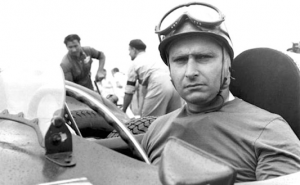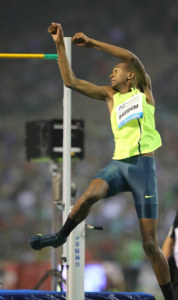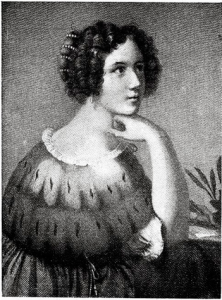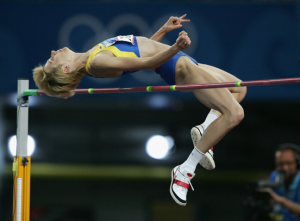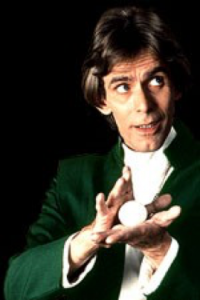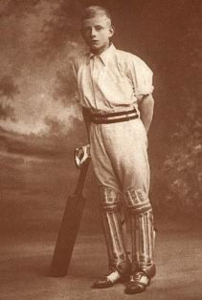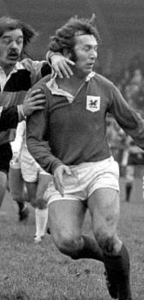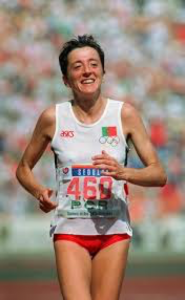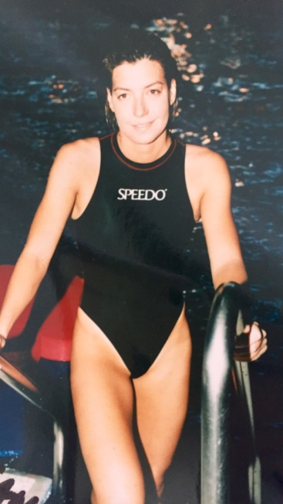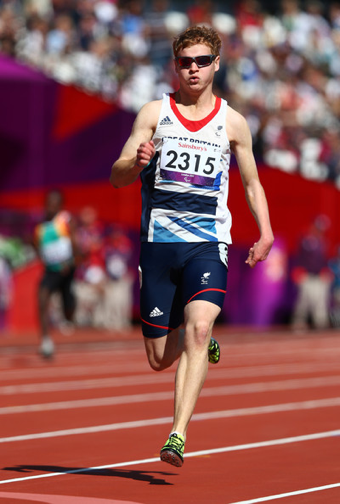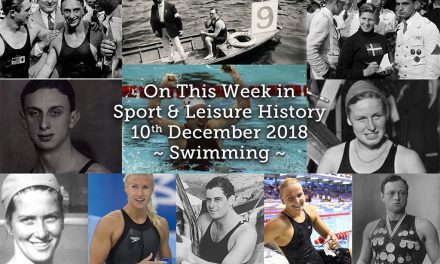24th
- American distance athlete Arthur Lee Newton was born in 1883. Competing in the 1900 Olympics, he finished 4th in the 2500m steeplechase and 5th in the Marathon. Four years later in the St Louis Games he won gold as part of the four mile team contest and bronze in both the Marathon and the steeplechase.
- Fellow countryman and Olympian Frank Verner shared Newton’s 1883 birthday. He won silver in the 1500m in 4:06.8, placed fourth in the steeplechase and sixth in the 800m.
- Another 1904 American Olympian Frank Waller was born in 1884. He won two silvers in the 400m flat and hurdles, behind gold medallist Harry Hillman in both events. He was US Champion in the men’s 440yds in 1905 and 1906, and the 220yds hurdles while competing for the Milwaukee Athletic Club.
- On this day on 1894 the decision was made to hold the modern Olympics every 4 years.
- Boxer Jack Dempsey was born in 1895 at Manassa, Colorado. Known as the ‘Manassa Mauler’, he won the heavyweight world title in 1919 by beating Jess Willard, the 17-stone (108kg) cowboy from Kansas. He lost it on points to Gene Tunney in 1926 and in the following year ‘was robbed of the title’ in the infamous ‘Battle of the Long Count’.
- At the 50th edition of the British Golf Open in St Andrews in 1910 James Braid shot a 299 to take the title.
- The first great motor-racing world champion, Juan Manuel Fangio of Argentina, was born in 1911. He won the title a record five times between 1951 and 1957. He won 24 world championship races, a record which stood until surpassed by the late Jim Clark in 1968. Fangio drove for all the great manufacturers of the 1950s, winning world titles for Alfa Romeo, Maserati, Mercedes and Ferrari.
- BBC television covered a Test match for the first time in 1938 when the screened part of the second Test against Australia from Lord’s. The highlight of the match was Walter Hammond’s 240 in England’s first innings.
- Dutch professional tennis player Betty Stöve was born on this day in 1945; best remembered for reaching the ladies’ singles final at Wimbledon in 1977. She also won ten Grand Slam titles in women’s doubles and mixed doubles. Stöve began playing tennis internationally in the mid-1960s. She made her Grand Slam debut at the 1964 Wimbledon. A virus, complicated by a malfunctioning thyroid gland, forced her out of tennis for an 18-month period in the late 1960s. Despite being advised that she should never play tennis again, Stöve recovered to have her best years on the circuit. Stöve’s most notable singles match was that 1977 Wimbledon final, which she lost to Virginia Wade: 4–6, 6–3, 6–1. Queen Elizabeth II, in her silver Jubilee year, attended the final against Wade. Stöve was also a semi-finalist at the 1977 US Open, losing to Chris Evert. She also found success in the 1977 US Open by winning the women’s doubles with Martina Navratilova and the mixed doubles with Frew McMillan. She had her greatest success in doubles. She won ten Grand Slam doubles championships, six in women’s doubles and four in mixed doubles. She won two women’s doubles championships with Billie Jean King and two with Wendy Turnbull. Her other two titles were won with Françoise Dürr and Martina Navratilova. All of her mixed doubles championships were with Frew McMillan. Stöve was the runner-up in seventeen Grand Slam doubles tournaments, eight in women’s doubles and nine in mixed doubles. During her career, Stöve won one singles title and 75 doubles titles. She reached a career-high singles rank of World No. 5 in 1977. She was also ranked World No. 1 in doubles. Stöve competed in and lost all three finals at Wimbledon in 1977, failing to win any of them; the last player in any Grand Slam event to earn such a record. She competed for the Netherlands Fed Cup team in 1966, 1969, 1970, 1971, 1972, 1976, 1977, 1978, 1979, 1980, 1982, and 1983.
- Raelene Boyle, Australian sprinter was born in 1951 and in 1998 was named one of 100 National Living Treasures by the National Trust of Australia. Her career started after a series of strong performances in the 1968 Australian Championships and Olympic trials, where she was selected to represent Australia at the 1968 Olympics, at the age of 16. At 17, she won a silver medal in the 200m and came 4th in the 100m, setting world junior records in both distances of 22.73, and 11.20. The 200m mark lasted 12 years and the 100m, 8 years. Together with two silvers from the 1972 Games where she came second behind East-German Renate Stecher in both sprint finals, Boyle has a string of Commonwealth titles to her name (seven gold and two silver). Some consider her a very unlucky athlete in never having won an Olympic gold especially since some athletes who beat her were later revealed to have used anabolic steroids.
- In 1972 South African athlete Danie Malan set a new 1000m world record in Munich.
- Mutaz Essa Barshim, Qatari high-jumper, who is the national and Asian record holder with a clearance of 2.43m, was born in 1991. He won a silver medal at the 2016 Summer Olympics in Rio de Janeiro and a bronze medal at the 2012 London Games He was the Asian Indoor and World Junior champion in 2010, and won the high jump gold medals at the 2011 Asian Athletics Championships and 2011 Military World Games.
- The current longest ever professional tennis match finished on this day in 2010. The men’s singles first round match between John Isner of the USA and Frenchman Nicolas Mahut began at 6:13pm BST on June 22nd, at 9:07pm, due to fading light, play was suspended before the start of the fifth set. After resuming the following day at 2:05pm, the record for previous longest match was broken at 5:45pm. The light faded again, and so play was suspended at 9:09pm, with the final set tied at 59 games all. Play resumed at 3:40pm on June 24th, and Isner won at 4:47pm, the final set having lasted 8 hours, 11 minutes.In total, the match took 11 hours, 5 minutes of play over three days, with a final score of 6–4, 3–6, 6–7(7–9), 7–6(7–3), 70–68 for a total of 183 games, by far the longest match in tennis history, measured both by time and number of games. The final set alone was longer than the previous longest match. Both players broke numerous Wimbledon and tennis records, including each serving over 100 aces, with the match being referred to as “the endless match”.
- On this day in 2012 female athletes from Saudi Arabia would be allowed to compete at the Olympic Games for the first time.
- Juan Manuel Fangio
- Mutaz Essa Barshim
25th
- On this day in 1678 the first Doctorate of Philosophy to be earned by a woman was awarded to Elena Lucrezia Piscopia. The University of Padua also awarded the 32-year-old the Doctor’s Ring, the Teacher’s Ermine Cape, and the Poet’s Laurel Crown. Dr. Piscopia was born into a noble Italian family in Venice. Her father was the Procurator of San Marco and her mother was also from the upper classes. She was the eldest daughter in her family and by age seven was already being tutored. She first studied Latin and Greek under distinguished instructors. After mastering these languages, she learned Hebrew, Spanish, French, and Arabic. With seven languages at her disposal, she was given the title “Oraculum Septilingue.” She went on to study mathematics, philosophy, and theology. In 1665 she took the habit of the Benedictine Oblate, however she never became a nun. Her father wanted her to enter the University of Padua. She excelled in her studies and was granted her PhD in the cathedral of Padua on this day. The University authorities were in attendance as were professors and the lesser faculty. Many of the students also came to witness this event along with a great number of prestigious invited guests from other Italian Universities. Elena spoke for an hour in classical Latin and explained random selections from the works of Aristotle. She was not permitted by the Catholic Church to receive a doctorate in theology. She went on to teach and write a variety of treatises before her death at age 38.
- On this day in 1910 Igor Stravinsky‘s ballet The Firebird is premiered in Paris, bringing him to prominence as a composer.
- The winner of the 1952 Olympic bronze in the 50k walk, Hungarian Antal Róka, was born on this day in 1927.
- In 1932 India made their Test cricket debut against England at Lord’s. England captained by Douglas Jardine, won by 158 runs.
- Doreen Wells, Marchioness of Londonderry, former ballet-dancer was born in London in 1937. She received her early dance training at the Bush Davies School of Theatre Arts, continuing her studies at the Sadler’s Wells Ballet School. She is a winner of the Adeline Genée Gold Medal from the Royal Academy of Dance and she made her professional stage debut in pantomime, before ultimately joining the Sadler’s Wells Theatre Ballet. In theatre, she has performed roles in West End musicals, including the leading role of Vera Baranova in On Your Toes at the Palace Theatre and Maggie Jones in 42nd Street at the Theatre Royal, Drury Lane. She has also made television appearances including the 1985 Royal Variety Performance and a BBC Christmas Extravaganza.On 1 December 2009, she made an appearance on The Paul O’Grady Show, performing a dance routine with male backing dancers. She was then interviewed by O’Grady and spoke of her continued love for dance and about how she still performs regularly.
- Australian athlete Judy Amoore was born in 1940. At the 1964 Olympics she won a bronze medal in the first 400m race for females, only beaten by countrywoman Betty Cuthbert and Brit Ann Packer. At the 1966 British Empire and Commonwealth Games in Jamaica she won the 440yds, and silver over 880yds as well as placing fourth in the 220yds. At the Australian championships in February 1964 she came 3rd in 440yds and 2nd in 880yds. In 1966 she competed in 100yds without reaching the final, but was 3rd in 220yds, 1st in both 440yds and 880yds.. In the state championships of Victoria she won both 220, 440 and 880yds races.As Judy Pollock, she set world records at 440yds (1965), 800m (1967) and 880yds (1967) before retiring due to pregnancy in 1968. She made a come-back in 1971, running some of her best times ever to make the team for the 1972 Olympics in Munich. She was Track and Field Team Captain at Munich, but was unable to compete because of injuries and retired soon after the Games; again for family reasons. In 1976, she made another comeback, now concentrating on 800m and 1500m. The veteran was selected in her third Olympic team after winning the 1500m at the Australian National Championships and running second to Charlene Rendina over 800m. So at the age of 36, she became the oldest Australian woman Olympian at the 1976 Montreal Games. Running in the 800m, she just missed the final, clocking her fastest ever time of 1:59.93 for fifth in her semi-final. Despite setting another personal best time in the 1500m, she was run out of her heat. She was inducted into the Sport Australia Hall of Fame in 1988.
- In 1947 The Diary of a Young Girl (better known as The Diary of Anne Frank) is published.
- Joe Louis made the 25th and last defence of his world heavyweight crown, against ‘Jersey’ Joe Walcott at the Yankee Stadium, New York, in 1948. Louis won with an 11th-round knockout. Eight months later, he announced his retirement.
- British Paralympic cyclist, Para-triathlete, adventurer and author Karen Darke was born in 1971. Darke is paralysed from the chest down following an accident, aged 21, whilst sea cliff climbing. In 2006, she took part in an expedition which crossed Greenland’s ice cap whilst sitting on skis using her arms and poles to cover the 372 mile crossing. She has also climbed Mont Blanc, Matterhorn and El Capitan and hand-cycled, skied and swam the length of Japan. In 2009, she was a bronze medal winner in the Para-Cycling World Cup after which, in 2010, she became a member of the British Para-Cycling team. She has won two silver medals in the women’s H2 road race and time trial events at the 2011 Para-Cycling World Cup. At the 2012 Summer Paralympics, she won a silver medal in the H1–2 road time trial and in the H1-3 road race finishing fourth, after crossing the finishing line holding hands with team mate Rachel Morris, both in a time of 1:43:08, Morris was awarded the bronze medal. In October 2012, she competed in her first ITU Para-triathlon World Championships. She won the gold medal in her TRI-1 classification. On 14 September 2016 Darke won the gold medal in the H1-3 time trial at the Rio Paralympics in a time of 33:44:93. She was appointed an MBE in the 2017 New Year Honours for services to sport.
- History is made on this day in 1972 when Bernice Gera becomes the first female umpire to officiate in pro baseball.
- In 1983 India beat the West Indies by 43 runs to win the Cricket World Cup.
- Today in 1991 a new tennis record is set as Martina Navratilova win hers 100th singles match at Wimbledon.
- Australian junior world 100m freestyle record holder Kyle Chalmers was born in 1998. She also won the gold medal in that event at the2016 Summer Olympics.
- Scottish National Hunt jockey Campbell Gillies died on this day in 2012 aged 21. He was most notable for his victory on Brindisi Breeze in the Albert Artlett Novices’ Hurdle at the 2012 Cheltenham Festival. In total, he rode 131 winners in his career, mainly for top Scottish trainer, Lucinda Russell and was widely considered by pundits and fans alike as one of the leading young jockeys in the UK.Gillies was found dead in a swimming pool at the Corfu holiday apartments where he was staying with fellow jockeys Henry Brooke, Nathan Moscrop, Harry Haynes and Mark Ellwood. The friends had returned from an evening out and had gone for a morning swim at around 8am local time. Gillies went under the water and failed to resurface. A Greek coroner recorded his death was caused by drowning and a police spokesman revealed that toxicological reports revealed he had been drinking.
- On this day in 2014 Luis Suarez is charged with biting at the 2014 FIFA World Cup.
- Elena Lucrezia Piscopia
- Campbell Gillies
26th
- The first recorded women’s cricket match was played at Gosden Common, Surrey in 1745.
- The first motor-racing grand prix, the French Grand Prix, was run at Le Mans in 1906. The Romanian Ferenc Szisz drove a Renault to victory at an average speed of 63mph (101km/hr).
- At the 60th British Golf Open at Prestwick Golf Course, on this day in 1925, Jim Barnes took the title, shooting a score of 300.
- Carlo Facetti, Italian racing car driver was born in 1935. He is mainly known for his success in touring car and sports car racing. In his single attempt at Formula One he failed to qualify for the 1974 Italian Grand Prix with a Brabham BT42 run by the Scuderia Finotto team.In 1979 he was the European Touring Car Champion. He was also 2nd in 1977 and 4th in 1978.
- The German pairs skater Margret Göbl was born today in 1938, together with her partner and future husband Franz Ningel, she was the 1962 World bronze medalist, a three-time (1960–1962) European medalist, and a three-time (1960–1962) German national champion. The pair also finished fifth at the 1960 Winter Olympics in Squaw Valley. She died on 21st June 2013 a few days short of her 75th birthday.
- On the same day in 1938 another famous female athete, the American golfer Myra Abigail Pankhurst, (later Pratt, later Wright, then Daria Karageorgevich), died at the age of 79. She competed in the 1900 Olympics and won a bronze medal. She was the daughter of daughter of John F. Pankhurst, vice-president of Globe Iron Works and co-owner of American Shipbuilding Company of Cleveland; divorcée of Herbert Wright in 1900; and widow of Thomas Huger Pratt. On 11th June 1913 she married, in Paris, Prince Alexis Karageorgevitch, (or Karađorđević) who was the head of the senior branch of the House of Karageorgevitch and a claimant to the Serbian throne. She was received in the Eastern Orthodox faith under the Slavic name of Daria. After honeymooning in Paris they left Europe to live in Daria’s home city of New York. During the First World War Prince Alexis and his new wife returned to Serbia to support the war effort with Prince Alexis serving as President of the Serbian Red Cross. After the fall of the wartime capital Niš to the Central Powers Prince Alexis and his wife had to take part in the mass retreat from Serbia through the treacherous mountains of Montenegro and Albania in the winter of 1915-1916. The couple arrived in Rome on Christmas Eve 1915. With the death of Prince Alexis in 1920, the male line of the senior branch of the Karageorgevitch dynasty became extinct.
- At the Yankee Stadium, New York, in 1959 Ingemar Johansson stopped Floyd Patterson by a technical knock-out, two minutes and three seconds into the third round of their contest, to become the heavyweight champion of the world and the first non-American since Italy’s Primo Carnera 25 years earlier to win the crown. In the 1952 Olympic heavyweight final Johansson had been disqualified in the second round for ‘not giving his best’ and as a consequence had not been presented with his silver medal. The IOC rescinded their decision and gave him the medal in 1982.
- The most successful American cyclist Greg LeMond, was born in 1960. Three times winner of the Tour de France, in 1986, 1989 and 1990, two of his wins came after he nearly list his life in a freak shooting accident. His 1986 win made him the first non-European professional cyclist to win the Tour de France, and he remains the only American cyclist to have won the Tour. (Lance Armstrong won a record seven consecutive times from 1999 to 2005. However, in 2012, he was banned from sanctioned Olympic sports for life as a result of long-term doping offenses. As part of those sanctions, all results going back to August 1998, including his seven Tour wins, were voided). LeMond has always been a vocal opponent of performance-enhancing drug use, and at times his commercial ventures have suffered for his anti-doping stance—as in 2001, when he first accused Lance Armstrong of doping and sparked a conflict that led eventually to the dissolution of his Lemond Bikes brand in 2008, which was licensed by Armstrong’s primary sponsor Trek Bicycles. As the lone American winner of cycling’s most prestigious race, LeMond has not enjoyed the public stature that might be expected of such a figure, but he continues to campaign publicly against doping and ineffective leadership by the UCI, the International Federation for Cycling. In December 2012, LeMond even articulated a willingness to replace the UCI president on an interim basis if called to do so.
- Finnish racing executive and forming WRC driver Tommi Mäkinen was born on this day in 1964. He is the head of the Toyota GAZOO Racing team. Mäkinen is one of the most successful WRC drivers of all time, ranking second in championships (4), tied with Juha Kankkunen and Sébastien Ogier and behind Sébastien Loeb (9), and fifth in wins (24). He is a four-time World Rally Champion, a series he first won, and then successfully defended, continuously throughout 1996, 1997, 1998 and 1999.
- Inha Babakova (née Butkus), former USSR and later Ukrainian high jumper, was born in 1967. She won Olympic bronze in Atlanta in 1996 and became World Champion in Seville 3 years later. She also won four other World Championship medals; bronze in 1991 and 1995 and silver in 1997 and 2001. Track and Field News magazine ranked her in the world’s top ten in their annual merit rankings for 13 out of 14 seasons (1991-2004), the exception being 1998. She was in the top five ten times. Only Stefka Kostadinova, among other female high jumpers, has more top ten rankings. Her 2.01 m clearance in Oslo on her 36th birthday in 2003 is the women’s W35 World Record.
- Ingrid Lempereur, Belgian breaststroke swimmer was born today in 1969. She won 200m breaststroke bronze at the 1984 Summer Olympics in Los Angeles, while only 15.
- Kenyan long-distance runner Paul Bitok, who won two silver medals at consecutive Olympics (1992, 1996) over 5000m, was born on this day in 1970. He emerged in 1992 as a relatively unknown athlete. He qualified for the Barcelona Games at the Kenyan trials and defeated several world class athletes at the Bislett Games in Oslo. By the time of the Olympics he had established himself as one of the favourites. He narrowly lost the final to Dieter Baumann of Germany. A few weeks later he won the 5000m in Zurich. In the following years Bitok did not match his performances of 1992. However, by 1996 he was back and won silver in Atlanta. He also won two World Indoor silvers (1997, 1999) at 3000m behind Haile Gebrselassie. He is married to Pauline Konga, who won the silver medal in women’s 5000m at the 1996 Olympics, becoming the first Kenyan female Olympic medallist.
- The only woman to win Olympic medals at both the 400m and 400m hurdles, Russian athlete Natalya Antyukh, was born in 1981. She won gold in 400m hurdles at the 2012 Summer Olympics, after winning bronze in the 400m at the 2004 Olympics. She is the only woman to win an Olympic medal in both the 400m hurdles and 400m. In addition to winning medals in individual contests, she has been a very successful relay runner, winning a silver medal at the 2004 Olympics. She announced her retirement in February 2017 just days after being stripped of her 4x400m Olympic silver medal from 2012 due to a teammate’s doping offences She was quoted as saying she had had “enough” of competing and would not race any more.
- Professional Sumo wrestler Toyonoshima Daiki was born in 1983, as Daiki Kajiwara. As a youngster he was an avid football player However, his destiny changed after winning an area boys’ sumo tournament championship. In high school, he was rivals with another future sumo wrestler who would go on to take the fighting name Kotoshōgiku. Kotoshōgiku is now a rival of his in professional sumo as well. After graduating from high school, Toyonoshima joined Tokitsukaze stable through a connection a friend of his father’s had with the stable. He was below the minimum height requirement of 173cm but was allowed to make his debut after passing a secondary physical exam He made his professional debut in January 2002, reaching the top makuuchi division in September 2004. He has been a runner-up in five tournaments, and has earned ten special prizes. His highest rank has been sekiwake, which he first reached in September 2008 and has held for five tournaments to date. Following a suspension in July 2010 he was demoted to the jūryō division, but upon his return to makuuchi in November 2010 he took part in a playoff for the championship. He has been runner-up in four other top division tournaments. He has four kinboshi or gold stars awarded for yokozuna upsets, three of them earned by defeating Harumafuji from 2013 to 2015.
- Estonian basketball player, Tõnno Lepmets, died on this day in 2005 aged 67.He competed for the Soviet Union and won gold with that nation’s basketball team at the 1963 and 1967 EuroBasket competitions.
- Jacobus Maria Bemelman, Dutch magician who performed under the stage name Tommy Wonder died in, 2006. He was best known for both close-up and stage magic, performing in Las Vegas, Monte Carlo and on Fox television Wonder developed an interest in conjuring at an early age. He studied acting, dancing and singing for three years at the Academie voor Podiumvorming (Performance Academy) in The Hague and subsequently toured for two years with De Haagsche Comedie. He took second prize at the World Championships of Magic in 1979 and again in 1988. In 1998 he also received the Performer Fellowship Award from the Academy of Magical Arts in Hollywood. In 1999, he was awarded Best Sleight of Hand Performer from the World Magic Awards. Because Wonder designed and developed his own entire repertoire, he was held in high esteem amongst his colleagues in magic. Wonder’s 1996 two-volume The Books of Wonder are highly acclaimed. Tommy Wonder died after a brief battle with lung cancer and on August 2006 posthumously received the Theory & Philosophy Award at the FISM World Championships of Magic in Stockholm.
- On the day in 2014 Luis Suárez was expelled from the 2014 FIFA World Cup following a biting incident.
- Inha Babakova
- Tommy Wonder
27th
- Guilhermina Suggia, Portuguese cellist, was born today in 1885. She studied in Paris with Pablo Casals, and built an international reputation. She spent many years living in the United Kingdom, where she was particularly celebrated. She retired in 1939, but emerged from retirement to give concerts in Britain. Her last was in 1949, the year before her death. Suggia bequeathed an important British scholarship for young cellists, which has been granted to performers including Rohan de Saram, Jacqueline du Pré, Robert Cohen and Steven Isserlis.
- Canada’s George Dixon beat Nunc Wallace with an 18th round knock-out in 1890 at the Pelican Club, London, to win the world bantamweight boxing title. It was the first world title fight under Queensberry Rules to be held in England.
- Today in 1899 AEJ Collins scored 628*runs, the highest ever recorded score in cricket for 116 years until it was broken in January 2016 by 15 year old Indian schoolboy Pranav Dhanawad, who scored 1009 in his single innings. Collins was 13 years old at the time and the score was accumulated over four days. He was born in India, where his father served as a judge in the Indian Civil Service. Both his parents had died before he started at Clifton College in September 1897. He played both rugby and cricket and received a bronze medal for boxing at the public school tournament in 1901. Collins was playing for Clarke’s House against North Town House and the teams were playing on a field which has since been renamed Collins Piece. The field was rough and in an unusual narrow shape and because of the oddity of the field shape, the three short boundaries only counted for two runs. The match began on Thursday, June 22 and Collins, who won the toss, chose to bat first with the game starting around 3.30pm. When play ended at 6pm, he had scored 200 runs. School lessons permitted another 2½ hours of play on Friday and news of the boy’s achievement had reached the college audience who all came to watch young Collins. He ended the day with a score of 509 although it was misreported in the papers as 510 and his name was listed as AEG Collins. Play resumed on Monday during the lunch hour and he ended with a score of 598. On Tuesday, June 27, the school authorities permitted a longer playing time to attempt to finish the match. Play ended with Collins scoring 628 – 1 six, 4 fives, 31 fours, 33 threes, 146 twos, and 87 singles. Despite all this, Collins never played professional sport. Instead he chose an army career and passed entrance exams to the Royal Military Academy which he entered in September 1901. He represented the Academy in both rugby and cricket and scored a century for them as well. He joined the British Army as a Second Lieutenant in the Royal Engineers in 1904. He continued to play sport for the military but never played first-class cricket. He was sent to France when World War I broke out and was killed in action on November 11, 1914 at the First Battle of Ypres having attained the rank of Captain.
- The first man to swim 100yds backstroke in under a minute, Adolph Kiefer, was born today in 1918. A gold medalist at the 1936 Olympics and one-time world record-holder, he also was an inventor and innovator of new products related to aquatics competition. He was only 16 when he clocked 59.8s at the Illinois High School Championships in 1935, the following year his time of 58.5s was to stand as the Illinois State High School record until 1960. All told he broke twenty-three records after breaking the one-minute backstroke mark. Kiefer set a world record for the 100m backstroke of 1:04.8 on January 18th , 1936, at Brennan Pools in Detroit, Michigan. Representing his country at only 18 in the 1936 Games he won 100m backstroke gold, setting new Olympic records in the first-round heats (1:06.9), the second-round heats (1:06.8), and the final (1:05.9). His Olympic Record would stand for over 20 years, finally broken by David Theile in the 1956 Games. In 1943 Kiefer was asked to audition for the role of “Tarzan”, but answered the call of arms instead, joining the Navy. In 1947, he established Adolph Kiefer & Associates in Chicago, which has provided swimmers with training, safety, and competition equipment. His company was responsible for the development of the nylon tank suit in 1948 and debuted the first nylon swimsuit supplied to the US Olympic Swim Team—a marked improvement over the wool and cotton suits available at the time. Kiefer subsequently devoted himself to community service, combining swimming and philanthropy in innovative ways. In the 1960s he worked with Mayor Daley to build swimming-pools across the inner city of Chicago, providing the facilities needed for thousands of children to learn to swim. Kiefer actively supported Swim Across America, a non-profit organization that raises funds for cancer research, and participated in SAA public swimming events well into his 70s and 80s. Kiefer was an “Honour Swimmer” member of the inaugural class inducted into the International Swimming Hall of Fame in 1965. In 1966 he patented the first design for a no-wave, non-turbulence racing lane. In 2008 Kiefer celebrated his 90th birthday in Omaha at the 2008 US Swimming Olympic Trials, where he awarded medals for the 200m backstroke. On June 27th 2012 he celebrated his birthday again in Omaha at the 2012 US Swimming Olympic Trials by awarding the medals for the 200m backstroke. In 2013 USA Swimming named Kiefer the “father of American swimming” in recognition of his contributions to American swimming. He died aged 98 on May 5th 2017.
- The American professional wrestler and football player, William Fritz Afflis, who went by the rather inglorious nickname of Dick the Bruiser, was born on this day in 1929.
- Patrick Sercu, Belgian cyclist was born today in 1944. On the track, he won gold in the 1km time trial at the 1964 Olympics, as well as three world titles in the sprint, in 1963, 1967 and 1969. On the road, he earned the green jersey in the1974 Tour de France. Sercu is the record holder for the number of six-day track race victories, having won 88 events out of 223 starts between 1961 and 1983; several of these wins were with cycling great Eddy Merckx. He also won six stages at the Tour de France and eleven stages at the Giro d’Italia.
- Former West-German field hockey player Heiner Dopp was born on this day in 1956. He competed at three Summer Olympics and won silver with his team, in the, Los Angeles Games of 1984 and Seoul, 1988, he made his Olympic debut in 1976 at Montreal. He played 286 international matches for the national team, and won the German club title eight times with TG Frankenthal. After his hockey career he became engaged in local politics and in 1999 became mayor of his home town Meckenheim.
- Born on this day in 1967 was Sylvie Fréchette, Canadian former synchronized swimmer, the1992 Olympic solo champion. In the technical figures routine, a Brazilian judge accidentally entered a score of 8.7 instead of 9.7, costing her first place, after several appeals by the Canadian Olympic Committee; her medal was upgraded to gold. Kristen Babb-Sprague, the beneficiary of the judge’s error, was allowed to keep her gold medal. Fréchette’s success in the pool continued with a silver medal in the women’s team event at the following Olympics. In 1999, she was inducted into Canada’s Sports Hall of Fame. She has also contributed as a swimmer, designer, and coach to the synchronized-swimming portions of Cirque du Soleil’s water-based stage production O, which opened in 1998 at the Bellagio hotel and casino in Las Vegas. In 2006, Fréchette became an ambassador for Oxfam.
- Also on this day in 1967: The world’s first ATMwas installed at Barclay’s in Enfield, London. A New York City bank had a similar machine installed back in 1939, but it was withdrawn after six months because no one used it! A quarter of a century later, managing director of De La rue Instruments, John Shepherd-Barron was so frustrated when he couldn’t access his account at the weekend, that he devised a machine that would allow him better access to his money. He created the “auto-teller.” The De La Rue Automatic Cash System worked with chemically coated cheques that were purchased in advance and could then be used when the bank itself was closed. Reg Varney, TV personality, was the first person to use the new machine. By the early 2000s, there were over 800,000 machines worldwide. Diebold, NCR, and Wincor Nixdorf are the top three manufacturers, but De La Rue still holds a 20% market share.
- The French World-Cup Alpine ski racer Régine Cavagnoud was born in 1970. She was the World Cup and World Champion in Super G in 2001. On October 29th of that year, she collided with German ski coach Markus Anwander during ski training in Pitztal, Austria, and sustained severe brain injuries. She was evacuated by helicopter to Innsbruck’s university hospital, where she succumbed to her injuries two days later. Her death was the first fatality involving a World Cup ski racer in over seven years, since the death of Austria’s Ulrike Maier in a downhill race in January 1994.
- The English badminton player who once held the world record for the fastest smash at 162mph, Simon Archer, was born today in 1973.
- Muhammad Ali announced his retirement from the boxing ring in 1979 after 50 professional fights dating back to 1960. The announcement came nine months after he regained the world heavyweight title for the second time with a points win over Leon Spinks at New Orleans. However, Ali was tempted out of retirement a year later and in October 1980 unsuccessfully challenged Larry Holmes for the title.
- Stefani Bismpikou (also spelled Bisbikou), Greek gymnast, was born in 1988. She competed at the 2004 and 2008 Olympics and is the first Greek female gymnast ever to win a medal at the European Championships and has also won several medals on the World Cup circuit. Her best apparatus is the beam, where she has an exceptionally high difficulty score.
- British athlete Stan Cox died on this day in 2012 aged 93. Born on 15thJuly 1918 he competed in the 1948 Olympic Games, served with the RAF in WWII, after returning to competition shape and qualifying he competed in the 10k at the 1948 Games, but was only allowed two days off work for those Games, one to observe the opening ceremonies and a second actually to compete. He was eventually placed 7th, but later claimed that he was told by 1924 Olympian Harold Abrahams that he had run an extra lap due to confusion caused by Emil Zátopek, and should have come 5th instead. In 1952, he was due to compete in the marathon, but after riding in a drafty aeroplane to the competition, he awoke the day of the race with a paralysed left side. It was later discovered that he was suffering from the flu. At the 1954 British Empire and Commonwealth Games, he suffered a sunstroke and collapsed within two miles (3km) of the finish. After retiring from running in 1956, he worked as a judge with Amateur Athletics Association. During his tenure at this job, he was hit by a javelin while judging the throw of another competitor, an incident that nearly killed him. Cox, who lived in Felixstowe for nearly 30 years, was seeking to take an active part in the 2012 Summer Olympics and a campaign began to make him a participant in the games’ ceremonies. He led a weekly walk group to remain fit and active, walking an average of four miles (6km) a day, until a year before his death.
- Carlo Pedersoli, professionally known as Bud Spencer, Italian actor, professional swimmer and water polo player, died today in 2016. He is known for action-comedy roles with his long-time film partner Terence Hill. The duo “garnered world acclaim and attracted millions to theatre seats”. Spencer and Hill appeared in, produced and directed over 20 films together. A successful swimmer in his youth, he obtained a degree in law and registered several patents. Spencer also became a certified commercial airline and helicopter pilot, and supported and funded many children’s charities, including the Spencer Scholarship Fund. He started to play water polo in 1949 for the Rome team Società Sportiva Lazio Nuoto and won the Italian swimming championships in freestyle and mixed relay teams. As a professional swimmer in his youth, Spencer was the first Italian to swim 100m freestyle in less than a minute (19th September 1950 in 59.5s) In 1949 he made his international debut and a year later he was called up for the European championships in Vienna where he swam in two finals, finishing fifth in the 100m and fourth in the 4×200m relay.In the 1951 Mediterranean Games in Alexandria he won 100m freestyle silver. Pedersoli participated in the 1952 Olympics in Helsinki, reaching the 100m freestyle semi-finals, a feat he duplicated four years later in Melbourne. As a water polo player, he won the Italian Championship in 1954 with S.S. Lazio and gold at 1955 Mediterranean Gamesin Barcelona with the Italian national team. His swimming career ended abruptly in 1957. On 17th January 2005, he was awarded the Caimano d’oro (Gold Caiman) by the Italian Swimming Federation.
- AEJ Collins
- Sylvie Fréchette
28th
- On this day in 1841 the Paris Opera Ballet premieres Giselle at the Salle Le Peletier.
- In 1846 Adolphe Sax patents the saxophone.
- On this day in 1859 the first “Breed” dog show, known as a conformation show, was held, where only specific breeds are evaluated. It is a method of seeing which of the purebred specimens conform best to the established breed type as laid down in the accepted breed standards. Judges are certified to evaluate only specific breeds, usually all in the same Group. There are a very few “All Breed” judges, as well. This first show, for pointers and setters, was held at Newcastle-upon-Tyne.
- Francis “Frank” Townsend Hunter, American tennis player was born on this day in 1894. Hunter is best remembered for his gold medal at the 1924 Paris Olympics, in the men’s doubles event with partner Vincent Richards. He was ranked World No. 4 in 1929 by A. Wallis Myers of The Daily Telegraph and World No. 5 in another Myers list in September the same year.
- Today in 1928 South African cricketer Peter Samuel Heine was born. He played in fourteen Tests from 1955 to 1962 and on debut he took five wickets in the first innings against England at Lord’s in 1955. A fast bowler renowned for his consummate hostility, he formed a potent Test combination with Neil Adcock. Heine picked up 277 first-class wickets at an average of 21.38, including a haul of 8 for 92 for Orange Free State against Transvaal in Welkom in 1954-55. He played for North-Eastern Transvaal in 1951-52 and 1952-53, Orange Free State in 1953-54 and 1954-55, and Transvaal from 1955-56 to 1964-65. Heine died on the 4 February 2005. He was the brother of tennis player Bobbie Heine Miller.
- Belgium road-racing cyclist Lucian Victor, winner of the men’s team gold at the 1952 Olympics with team-mates André Noyelle and Robert Grondelaers, was born today in 1931.
- In 1930 Mick the Miller won his second successive Greyhound Derby to become the first dog to win the race twice.
- Another cricketer, West Indian Roy Gilchrist was born in 1934. He played 13 Tests for the West Indies in the 1950s. Gilchrist’s Test career might have been longer had he not been sent home halfway through West Indies’ 1958–59 tour of the Indian subcontinent after disagreements with captain Gerry Alexander. One cause of this was Gilchrist’s “penchant for bowling beamers from 18 yards” as Cricinfo has put it, as well as off-field arguments. This involved deliberately overstepping the bowling mark by four yards to come closer to the batsman and intimidate him. In the Fourth Test at Nagpur, after Indian batsman AG Kripal Singh had struck three consecutive boundaries and taunted him, Gilchrist deliberately overstepped the bowling mark by six metres and delivered a bouncer which hit the Sikh batsman on the head and dislodged his turban. In the following match, against North Zone, he unleashed a barrage of beamers against Swaranjit Singh, whom Alexander had known at Cambridge. He ignored his captain’s instruction to cease this form of attack. During the lunch interval Alexander substituted him, and he was subsequently sent home, while the other players proceeded to Pakistan for the remainder of the tour. Alexander told him: “You will leave by the next flight. Good afternoon.” This marked the end of his Test career. There were suggestions that he had pulled a knife on Alexander. He later attracted attention while playing in the Lancashire League by removing a stump from the playing arena and striking an opposition batsman in the head. Gilchrist was said to be one of only four bowlers ever to have actually hit the sightscreen after first bounce on the pitch, on the full – There is some doubt about this, as the scorebook for the match in question, however, showed only three extras. After the end of his Test career he spent many years playing in the English Lancashire League, reaching 100 wickets each season until 1979, but there were continued stories of his violent temper. In 1967, Gilchrist was sentenced to three months’ probation after attacking his wife Novlyn during an argument. The judge in the case said: “I hate to think English sport has sunk so far that brutes will be tolerated because they are good at games.” He returned to India in 1962-3, playing for Hyderabad and South Zone.
- On this day in 1948 Dick Turpin beat Vince Hawkins to win the middleweight championship at Villa Park in Birmingham and therefore become the first black British boxing champion in the modern era. He was the oldest of the three Turpin boxing brothers, although not the most famous. He was 27 at the time of the bout. Jack was the third brother and a featherweight. Dick’s first professional fight was on March 30th 1939 against Jimmy Griffiths. Turpin lost on points over ten rounds, but a rematch held on April 17thsaw Turpin taking the win.
- At the small Brazilian mining town of Belo Horizonte in 1950 the USA brought off the shock in this history of the World Cup by defeating the joint tournament favourites England 1-0 in a group match. The England team contained some of the biggest names in the game; Billy Wright, Stan Mortensen, Bert Williams, Tom Finney and Wilf Mannion. The US team were made up of part-timers moulded together by Scotsman Bill Jefffrey. Haiti-born Joseph ‘Larry’ Gaetjens scored the only goal, which came in the 37th minute. The result was flashed abound the world but most newspapers thought that the agencies had made a mistake and that the score line should have read 10-1 to England. How wrong were they! Gaetjens, the goal-scoring hero, disappeared mysteriously during troubles times in his home country in 1970.
- Australian rugby league twin brothers, props Andrew and David Fifitawere born in 1989. Andrew played for Cronulla-Sutherland Sharks in the National Rugby League and has also been an Australian and Tongan international as well as representing NSW and Indigenous All-Stars. David plays for Wakefield Trinity Wildcats in the Super League.
- Australian tennis player Nicole Rottmann was also born on this day in 1989. She has won two singles and 13 doubles titles on the ITF tour and in 2012, reached her best singles ranking of world number 307. On 29 October 2012, she peaked at world number 185 in the doubles rankings. Rottmann has a 2–1 win–loss record for Austria in Fed Cup competition.
- Another sportswoman with a 1989 birthday today is Russian ice dancer Julia Sergeyevna Zlobina. Competing for Azerbaijan with partner Alexei Sitnikov, she is the 2013 Golden Spin of Zagreb champion, 2013 Volvo Open Cup champion, 2012 Nebelhorn Trophy silver medalist, and 2013 Winter Universiade silver medalist. They competed at the 2014 Winter Olympics, finishing 12th, and have placed as high as sixth at the European Championships (2014).
- FIFA announced the first change in football’s offside law for 65 years in 1990 when they decided that players level with defenders would, in future, be on side.
- Soviet-Latvian Chess Grandmaster and eighth World Chess Champion (1960/61), Mikhail Tal, died today in 1992. Widely regarded as a creative genius and the best attacking player of all time, Tal played in a daring, combinatorial style. His play was known above all for improvisation and unpredictability. Every game, he once said, was as inimitable and invaluable as a poem. In addition, Tal was a highly regarded chess writer. He also holds the records for both the first and second longest unbeaten streaks in competitive chess history.
- Guy Nève de Mevergnies, commonly known as Guy Nève, Belgian racing driver, was killed . in practice for a Procar endurance race on a temporary track in Chimay, Belgium, on this day in 1992. While driving a Porsche 911, Nève clipped a competitor, veered off the track and hit a grass bank, flipping several times before coming to rest on its roof. During the crash, fuel ignited and set the car on fire. Nève was 37 years old. He was the younger brother of fellow racer Patrick Nève.
- Croatian tennis player Donna Vekić, was born in 1996. She has won one singles title on the WTA tour as well as five singles and one doubles title on the ITF circuit in her career. On 15 July 2013, she reached her best singles ranking of world no. 62. On 2 February 2015, she peaked at world no. 310 in the doubles rankings. A member of the Croatia Fed Cup team, in February 2012 she played three rubbers at the tournament, helping her country to a 2–0 win over Bosnia and Herzegovina.
- On this day in 1997 the Evander Holyfield vs. Mike Tyson II WBA Heavyweight Championship match, billed as “The Sound and the Fury” and afterwards infamously referred to as “The Bite Fight”, took place. It achieved notoriety as one of the most bizarre fights in boxing history, after Tyson bit off part of Holyfield’s ear. Tyson was disqualified from the match and lost his boxing license, though it was later reinstated.
- Canadian ice hockey player Walter Peter Stanowski died in 2015. Stanowski started his National Hockey League career with the Toronto Maple Leafs in 1939. In 1941, he was a member of the NHL All-Star Team. He won four Stanley Cups with the Maple Leafs. Stanowski was traded to the New York Rangers after the 1947-48 season and he retired at the end of 1951. He was the last surviving member of Maple Leafs 1942 and 1945 Stanley Cup team and at the time of his death, Stanowski was the oldest surviving Maple Leaf.
- What the judges are looking for in a Breed Show
- Nicole Rottmann
29th
- On this day in 1613 London’s Globe Theatre burnt to the ground. The theatre, associated with William Shakespeare was built by his playing company in 1599 on Maiden Lane (today called Park Street) in Southwark. The Lord Chamberlain’s Men, a playing company established around 1594, performed at The Theatre in Shoreditch until problems with the landlord forced a move to Curtain Theatre close by. The company worked there from 1597 until December 28, 1598 when The Theatre in Shoreditch was dismantled. The beams were transported to Southwark and used in building the new venue, Globe Theatre.
- Dutch backstroke specialist Bartholomeus Roodenburch was born in 1866. At 42, he participated in the 100m backstroke at the 1908 Olympics, but he was eliminated in the first round, finishing 13th with a time of 1:36.2.
- British Track and Field athlete and winner of the 5 miles at the 1906 Olympics, Henry Courtenay Hawtrey was born on this day in 1882. The British were the leading force in the long-distance running in early 1900s. Although the most celebrated long distance runner Alfred Shrubb had turned professional just before the 1906 “intercalated” Olympics, the Britons sent a very good team to Athens .Hawtrey served with the Royal Engineers in the First World War. He was awarded the DSO and made a Companion of the Order of St Michael and St George in the 1918 New Year Honours.
- The Headingley ground in Leeds was used for Test cricket for the first time in 1899 when England and Australia fought out a low-scoring draw.
- On this day in 1927: The Bird of Paradise arrived in Hawaii. The plane was an Atlantic-Fokker C-2 and crewed by First Lt. Lester Maitland and First Lt. Albert Hegenberger. It was the first transpacific flight from the mainland to Hawaii.
- Japanese professional baseball player and one of Nippon Professional Baseball’s (NPB) greatest catchers, Katsuya Nomura, was born in 1935. He also served as manager of the Yakult Swallows for eight seasons, led the Hanshin Tigers for three years, and skippered the Rakuten Golden Eagles for four seasons. With 657 home runs and 1988 RBI, Nomura ranks number two on the career NPB lists in both categories, behind Sadaharu Oh. Nomura was elected to the Japanese Baseball Hall of Fame in 1989.
- John Dawes, Welsh rugby union player was born in South Wales in 1940. Dawes played club rugby for Newbridge in Monmouthshire, and then joined London Welsh, winning his first cap for Wales against Ireland in 1964. He was selected for Wales’ first overseas tour later the same year and played in the Welsh rugby team’s first match outside of Europe and its first in the Southern Hemisphere; against East Africa in Nairobi on 12 May 1964, Wales winning 26-8. He went on to make twenty two appearances for his country, captaining the side in six of them, including leading the Grand Slam winning side of 1971. In 1971, Dawes was appointed captain of the British and Irish Lions side for the tour to New Zealand. This side, coached by Carwyn James, became the first and so far the only Lions team to win a series in New Zealand. Dawes was also captain of the Barbarians side that beat New Zealand in Cardiff in 1973. Today he holds a proud record for any Welshman in the fact that as a player or coach he has never lost to an England side. After retiring as a player, Dawes became coach of the Welsh national side in 1974, a post he held until 1979. This was one of the most successful periods in the history of Welsh rugby, with the team winning the Five Nations Championship four times in the five seasons between 1975 and 1979, including two Grand Slams. He also coached the 1977 British Lions tour to New Zealand, but was unable to repeat the success of 1971.
- Sue Brown, who made history in 1981 as the first woman to compete in the Boat Race, as cox, was born in 1958.
- Portuguese marathon runner, the first sportswomen from Portugual to win a Olynmpic gold – Rosa Mota was born in 1958. Mota was also the first woman to win multiple Olympic marathon medals as well as being the only woman to be the reigning European, World, and Olympic champion at the same time. On the 30th Anniversary Gala of the Association of International Marathons and Distance Races (AIMS) she was distinguished as the greatest female marathon runner of all time. Despite all her success Mota suffered from sciatica and asthma as a child, yet, in 1991, she continued winning, this time the London Marathon. Later that year, Mota had to abandon the Tokyo World championships and she finally considered retirement after failing to finish the 1992 London marathon. Mota ran 21 marathon races between 1982 and 1992. She averaged two marathons a year for a decade and won 14 of those races.
- The heaviest-ever world boxing champion, Primo Carnera, died in 1967 at the age of 60. Nicknamed the Ambling Alp, the Italian was World Heavyweight Champion from June 29, 1933, to June 14, 1934.
- Today in 1974 Mikhail Baryshnikov defected from the Soviet Union to Canada while on tour with the Kirov Ballet.
- In 1975 Steve Wozniak tested his first prototype of Apple I computer.
- Marleen Veldhuis, was born in 1979, a retired swimmer from the Netherlands. She was world record holder in four events (one individual event and three relay events). Veldhuis won eight world championships golds and 20 European championships golds. In the Olympics, she won bronze at London 2012 in the 50m freestyle, as well as three relay medals: bronze in Athens 2004, gold in Beijing 2008, and silver in London 2012.
- Pierre Balmain, French fashion designer died today in 1982. He was the founder of the leading post-war fashion house Balmain. Known for sophistication and elegance, he described the art of dressmaking as “the architecture of movement.”
- On this day in 2007 Apple released its first mobile phone, the iPhone.
- John Dawes
- Rosa Mota
30th
- Today in 1859: Charles Blondin crosses Niagara Falls on a tightrope. Blondin was born in St. Omer, France in 1824. At the age of five, he was sent to École de Gymnase in Lyon by his gymnast father. After only six months of training, he made his first public appearance with the name “The Little Wonder.” His naturally graceful moves along with learned skills made him a favorite attraction. He also was said to have a charismatic personality, did everything in a grand way, and was a true showman. Blondin’s showmanship abilities along with fearless daring led him to increasingly dangerous undertakings. By the age of 35, playing to international audiences, he crossed the Falls on a tightrope 3 inches thick, 1,100 feet long and 160 feet above the water. Once he had crossed the Falls, he needed to keep the audiences wowed and devised ever more bizarre crossings. He crossed blindfolded, in a sack, with a wheelbarrow, on stilts, carrying his manager – Harry Colcord – on his back, and stopping midway and sitting down to cook and eat an omelette.
- The so called “Father of the Modern Day Hot Air Balloon”, Ed Yost, was born on this day in 1919. Yost developed and flew the first prototype of the modern hot-air balloon in a tethered flight. The envelope was plastic film, and heat was provided by burning kerosene. This prototype flight uncovered conceptual flaws that Yost worked to overcome. On 22 October 1960, Yost made the first-ever free flight of a modern hot-air balloon from Bruning, Nebraska. His balloon flew untethered for 1 hour and 35 minutes with the aid of heat generated by a propane burner. The balloon’s 40-foot (12 m) envelope was sewn from heat-resistant fabric especially selected by Yost for this purpose. After further refining and improving on this designs and materials, in 1963 Yost piloted the first modern balloon flight across the English Channel with crew member Don Piccard in a balloon later named the “Channel Champ.” All-told Yost set 13 aviation world’s records for distance travelled and amount of time aloft in his attempt to cross the Atlantic Ocean —solo— by balloon. He designed and built his balloon, the “Silver Fox,” himself, partly in his home garage. It featured a gondola that was shaped like a boat in the event that he would be forced down at sea — which is precisely what occurred. Although he had travelled far in excess of the distance needed to reach Europe from his launch point off the coast of Maine, his flight path began to point South rather than the hoped-for East direction due to inaccurate weather forecasting. The dream was achieved two years later with Yost’s assistance in a Yost-built balloon, Double Eagle II.
- Cricketer Michael John Knight Smith, better known as MJK Smith or Mike Smith was born in 1933. He was captain of Oxford University Cricket Club in1956, Warwickshire County Cricket Club from 1957to 1967 and England between 1963 and 66. He was one of England’s most popular cricket captains and, as he also played rugby union.
- England beat Australia 17-1 in Sydney in 1951 to record the biggest win in a football international, although the Football Association do not list the match as a full international.
- The first Chevrolet Corvette rolled off the production line on this day in 1953.
- Olha Bryzhina, former Russian and Ukrainian 400m runner was born in 1963. A triple Olympic gold medallist as well as one silver, she was also world champion in 1987. Bryzhina successfully defeated Florence Griffith Joyner at the 1988 Seoul Olympics in the 4×400m relay. Both runners ran the final leg of the relay and took the baton at about the same time. “Flo-Jo” ran a well-paced race, chasing Bryzhina closely, and tried to challenge Bryzhina at the 300m point. However, the challenge from Flo-Jo was unsuccessful and Bryzhina won by a 4m margin, taking gold for the Soviet Union along with a new world record for the USSR team. Bryzhina’s time of 47.7 seconds in the 1988 Olympic relay is one of the fastest relay legs ever run by a woman in the history of track and field. He husband Viktor Bryzhin was also a champion track athlete, winning gold in the 4x100m relay at the 1988 Olympics. Together they have a daughter, Yelizaveta Bryzhina, who is also a successful track runner, specialising in the 200m (Yelizaveta competes for Ukraine). Bryzhina and her daughter Yelizaveta both had a best performance of 22.44 seconds over 200m.
- The former world heavyweight boxing champion Mike Tyson was born in 1966. He was only 20 years 144 days old when he beat Trevor Berbick for the WBC version of the world championship in 1986, making him the undisputed champion of the world, beating Tony Tucker in the following year. The seemingly invincible Tyson was knocked out in the 10th round of his bout with James ‘Buster’ Douglas in Tokyo in 1990.
- Swedish javelin record holder and one time world record holder Patrik Bodén was born in 1967.
- Sandra Cam, winner of over 35 Belgian National Swimming titles between 1986 and 1997, was born in 1972. She represented her country in two consecutive Summer Olympics, in Barcelona, 1992 and Atlanta in 1996.
- A Newcastle in 1990 jockey Willie Carson became only the third man, after Gordon Richards in 1933 and Alec Russell in 1957, to ride six winners at one race meeting. The winners, and prices, were: Arousal, evens favourite; Sowento 5-2 fav; Al Maheb 9-2; Terminus 8-1; Tadwin 5-1; Hot Desert 4-7 fav. In the seventh race of the meeting Carson came home last on Parliament Piece.
- Duke McKenzie became the first British-based boxer to win world titles at two different weights; when he beat Gaby Canizales for the WBO bantamweight title at Southwark in 1991, he had previously held the IBF flyweight crown, between October 1988 and June 1989.
- Welsh Paralympic sprinter Rhys Jones was born in 1994. He qualified for the 2012 Paralympics in the 100m and 200m sprints. Making the final of the 200m at his first major games. Jones, who has cerebral palsy, played football for a pan-disability side before switching to athletics after attending a Disability Sports Wales trial. He attended his first junior competition, in Blackpool in 2008, winning four gold medals in the T37 category. By 2010 he was entering senior championships, competing in sprints and the long jump in the 2008 CP National Championships in Nottingham. He posted two personal bests in 2012, 12.25s in the 100m sprint at Birmingham and 25.24s in the 200m in the London Disability Athletics Challenge. He qualified for the 2012 Paralympics and followed his first Paralympic Games by qualifying for this 2013 IPC Athletics World Championships in Lyon finishing 7th in the 100m and 8th in the 200m.In 2014 Jones was named in the Wales squad for the 2014 Commonwealth Games in Glasgow. He ran in the T37 100m, qualifying through the first heat in second place with a time of 12.10 and in the final he posted a time of 12.04 to take the bronze medal. The following year Jones was named in the Great Britain team for the 2015 IPC Athletics World Championships in Doha. He competed in the T47 100 metres, and qualified through the first heat in fourth place. The next day, in the final, he finished eighth in a time of 12.12. In 2016 Jones competed at the IPC Grand Final at the Olympic Park in London. Now focusing solely on the 100m, he finished third in a time of 11.87, a season’s best, Jones’ results in 2016 saw him qualify for the 2016 Paralympics in Rio. Competing in the100m T37 he qualified as a fastest loser in the heats.
- German modern dance choreographer, dance teacher and ballet director “Pina” Bausch died aged 68 on this day in 2009. With her unique style, a blend of movement, sound, and prominent stage sets, and with her elaborate collaboration with performers during the development of a piece (a style now known as Tanztheater), she became a leading influence in the field of modern dance from the 1970s onwards. She created the company Tanztheater Wuppertal Pina Bausch which performs internationally.
- Sandra Cam
- Rhys Jones


